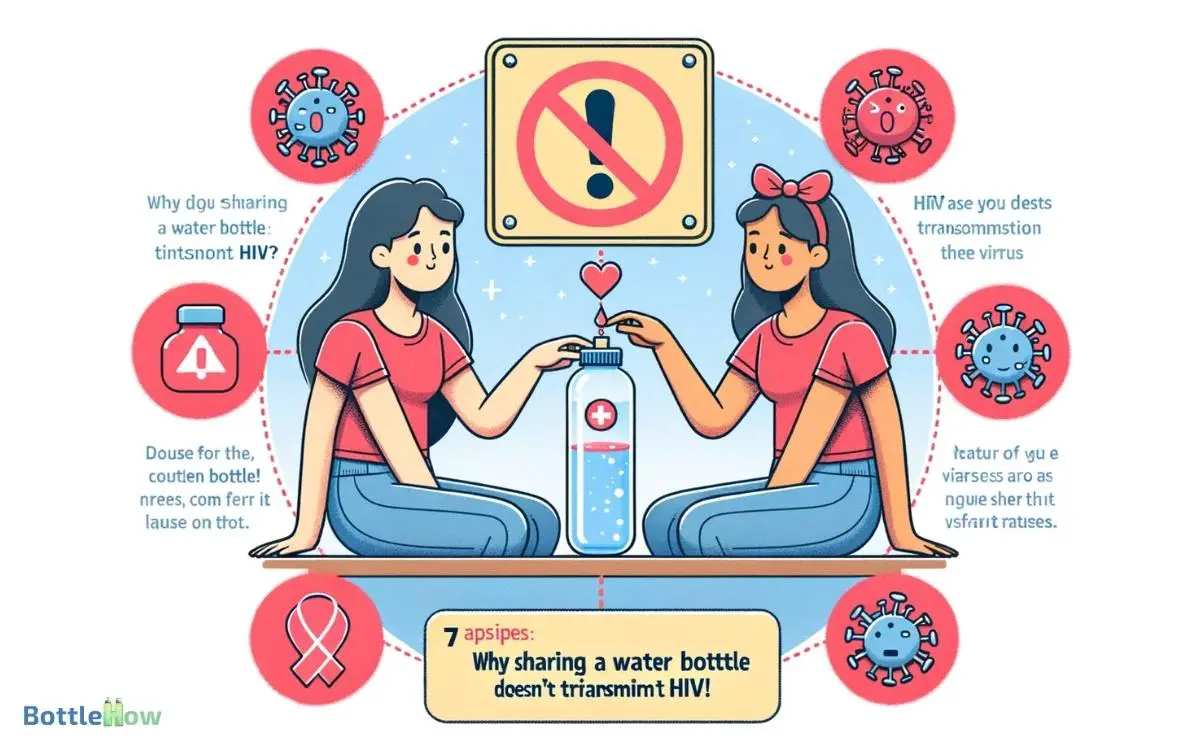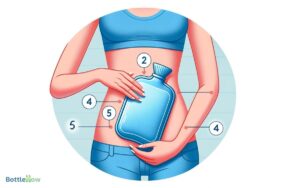Can You Get HIV by Sharing a Water Bottle? No!
You can’t get HIV by sharing a water bottle. HIV spreads through specific bodily fluids like blood, semen, vaginal fluids, rectal fluids, and breast milk. It requires direct contact with mucous membranes or damaged tissue, which sharing a water bottle doesn’t involve.
The virus doesn’t survive well outside the human body and isn’t transmitted through saliva. Casual contact, such as sharing utensils or drinking from the same bottle, poses no risk of HIV transmission.
Misconceptions about how HIV spreads can lead to unnecessary fear and stigma. For accurate information on HIV prevention, continue exploring this topic.

Key Takeaways
Understanding HIV Transmission
When understanding HIV transmission, it’s important to know that the virus primarily spreads through specific bodily fluids such as blood, semen, vaginal fluids, rectal fluids, and breast milk.
These fluids must come into direct contact with a mucous membrane or damaged tissue, or be directly injected into the bloodstream for transmission to occur.
Key mucous membranes are found in the rectum, vagina, penis, and mouth. You should be aware that activities like unprotected sex, sharing needles, and from mother to child during childbirth or breastfeeding are common transmission routes.
Common Transmission Myths
You might’ve heard that HIV can be transmitted through casual contact like sharing a water bottle, but this is a misconception.
Scientific evidence shows that HIV can’t survive long outside the human body, making non-infectious scenarios such as sharing utensils or using the same bathroom safe.
Understanding these myths helps reduce unnecessary fear and stigma surrounding HIV.
Casual Contact Misconceptions
Many people mistakenly believe that HIV can be transmitted through casual contact, such as sharing a water bottle, but this is not supported by scientific evidence.
HIV is primarily spread through specific activities involving the exchange of bodily fluids like blood, semen, vaginal fluids, and breast milk. Casual interactions do not pose a risk for HIV transmission.
Here’s a quick comparison to help clarify:
| Activity | HIV Transmission Risk | Scientific Evidence |
|---|---|---|
| Sharing a water bottle | None | No blood/fluid exchange |
| Hugging | None | No blood/fluid exchange |
| Using the same toilet | None | No blood/fluid exchange |
Understanding these facts helps dispel myths and reduces unnecessary fear and stigma associated with HIV.
Non-Infectious Scenarios
Understanding that casual contact can’t transmit HIV, let’s address other common myths about non-infectious scenarios.
You won’t contract HIV from sharing utensils, toilets, or swimming pools. The virus can’t survive long outside the human body, so it becomes inactive on surfaces.
Additionally, HIV isn’t spread through saliva, sweat, or tears, so kissing, hugging, or shaking hands are safe.
The virus requires direct access to the bloodstream through significant fluid exchange, like blood, semen, vaginal fluids, or breast milk.
Even mosquito bites don’t transmit HIV; the virus doesn’t replicate within insects. It’s essential to rely on scientific evidence to dispel these myths and focus on actual risk factors to prevent misinformation and unnecessary fear.
How HIV Is Not Spread
Contrary to common misconceptions, HIV isn’t spread through casual contact such as sharing a water bottle.
The virus requires specific conditions to be transmitted, and casual interactions don’t meet these criteria.
For instance, HIV can’t survive long outside the human body, making it impossible to contract the virus from surfaces or objects.
Here are other examples of how HIV isn’t spread:
- Hugging: Physical touch like hugging poses no risk.
- Kissing: Saliva doesn’t contain enough of the virus to cause infection.
- Sharing utensils: Eating or drinking from the same dishes is safe.
- Toilet seats: HIV can’t be transmitted via toilet seats.
- Insect bites: Mosquitoes and other insects don’t transmit HIV.
Understanding these facts helps reduce unnecessary fear and stigma.
Risk Factors for HIV
When considering the risk factors for HIV, you should primarily focus on unprotected sexual contact and sharing contaminated needles.
Evidence shows that these behaviors greatly enhance your chances of transmission. It’s important to understand these risks to adopt effective preventive measures.
Unprotected Sexual Contact
Unprotected sexual contact remains one of the primary risk factors for HIV transmission, as the virus can be easily transmitted through bodily fluids exchanged during intercourse.
When you engage in sexual activities without a condom or other barrier methods, you increase your risk of contracting HIV.
Factors that influence this risk include:
- Type of Sexual Activity: Some activities, such as anal intercourse, carry higher transmission risks.
- Presence of STIs: Having other sexually transmitted infections can make you more susceptible to HIV.
- Viral Load: The higher the viral load in an HIV-positive partner, the greater the risk of transmission.
- Frequency of Contact: More frequent unprotected sex increases cumulative risk.
- Lack of Pre-Exposure Prophylaxis (PrEP): Not using PrEP significantly heightens your risk of contracting HIV.
Understanding these factors can help you make informed decisions about your sexual health.
Contaminated Needle Sharing
Sharing contaminated needles poses a significant risk for HIV transmission due to the direct exchange of blood between users.
When you inject drugs with a needle that someone else has used, you’re exposing yourself to any blood-borne viruses they might carry, including HIV.
The virus can survive in a used syringe for up to 42 days, depending on environmental conditions.
This risk is heightened in environments where needle-sharing is common and access to clean needles is limited.
Public health initiatives, like needle exchange programs, aim to reduce this risk by providing sterile needles and promoting safe injection practices. If you’re using needles, it’s vital to use a new, sterile one each time to protect yourself from HIV and other infections.
Everyday Interactions and HIV
In everyday interactions, the risk of HIV transmission is virtually nonexistent, as the virus can’t survive long outside the human body or be transmitted through casual contact such as sharing a water bottle.
HIV transmission requires specific conditions, typically involving direct contact with certain body fluids.
Here are some key points to understand:
- HIV is primarily spread through blood, semen, vaginal fluids, rectal fluids, and breast milk.
- The virus can’t be transmitted through saliva, sweat, or tears.
- Casual contact, like hugging or shaking hands, poses no risk.
- Sharing utensils, food, or drinks doesn’t transmit HIV.
- HIV can’t survive on surfaces or in the air, making everyday interactions safe.
Understanding these facts helps dispel myths and reduces unwarranted fear.
Protecting Yourself and Others
To protect yourself and others from HIV, it’s vital to understand and practice safe behaviors. Condoms are highly effective in preventing the transmission of HIV and other sexually transmitted infections (STIs) when used correctly.
Additionally, never share needles or other drug paraphernalia, as this can transmit HIV through blood contamination.
Regular HIV testing is also important, especially if you engage in high-risk behaviors. Early detection allows for timely treatment, reducing the risk of transmission.
Furthermore, if you’re HIV-negative but at high risk, consider pre-exposure prophylaxis (PrEP), a medication that lowers the chance of infection.
Promoting Accurate Knowledge
Accurate knowledge about HIV transmission is essential to dispel myths and reduce stigma. You should understand that HIV can’t be transmitted through casual contact, such as sharing a water bottle. Promoting accurate information helps create an informed community.
Here are critical points to keep in mind:
- Modes of Transmission: HIV is primarily spread through blood, semen, vaginal fluids, rectal fluids, and breast milk.
- Casual Contact: Sharing utensils, hugging, or shaking hands doesn’t transmit HIV.
- Prevention Methods: Using condoms, pre-exposure prophylaxis (PrEP), and regular testing help reduce the risk.
- Stigma Reduction: Educating others can combat discrimination and promote empathy.
- Medical Advances: Antiretroviral therapy (ART) allows people with HIV to lead long, healthy lives.
Understanding these facts fosters a compassionate and informed society.
Conclusion
Just as you wouldn’t catch a cold from a handshake, you can’t get HIV from sharing a water bottle. HIV transmission requires specific conditions that everyday interactions don’t provide. HIV is primarily spread through unprotected sexual contact, sharing needles, or from mother to child during birth or breastfeeding. Casual activities like sharing food, using the same utensils, or even kissing do not pose a risk for transmission. Similarly, you might wonder, can you get herpes from sharing drinks? While herpes can spread through direct contact with a sore or saliva, the risk from sharing a drink is quite low.
Understanding this helps you navigate relationships without fear. By grasping the science behind HIV, you can protect yourself and others more effectively.
Let’s dispel myths and foster a community grounded in accurate knowledge—because when we’re informed, we act better.





